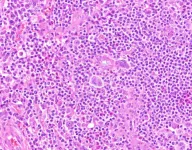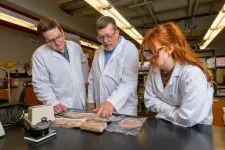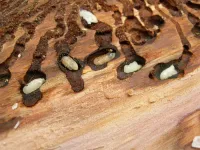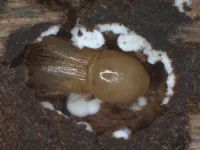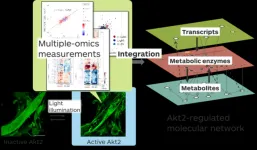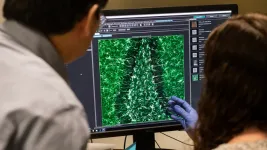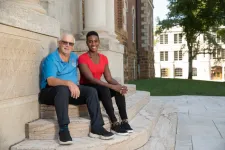(Press-News.org) CLEVELAND: Supported by a new $3.14 million grant from the National Institutes of Health to Cleveland Clinic, researchers are using an emerging technology known as “digital twins” to better understand healthcare disparities based on where someone lives. Researchers from Cleveland Clinic and MetroHealth aim to use this information to develop strategies designed to reduce these disparities in health outcomes.
The research team, led by Jarrod Dalton, Ph.D., of Cleveland Clinic, and Adam Perzynski, Ph.D., of MetroHealth, will use digital twins - sophisticated data models built from electronic health records - to analyze health trends from a combined research registry of more than 250,000 patients from the health systems.
This technology aids in accurately representing complex economic, environmental and social factors that can lead to disparities between neighboring communities.
“Where a person lives or works can shape their health outcomes - including life expectancy and risk of developing diseases like cancer or diabetes. Americans from socioeconomically disadvantaged communities are more likely to have heart attacks and stroke, and are expected to live 10 fewer years than wealthier Americans,” said Dr. Dalton, director of Cleveland Clinic’s Center for Populations Health Research. “Our goal is to design an approach to help health systems, governments and organizations collaborate and strategize ways to address clear disparities.”
The grant builds upon previous research published by Drs. Dalton and Perzynski in the Annals of Internal Medicine that the neighborhood where people reside may be linked with risk of cardiovascular events. They analyzed patient data and found people from socioeconomically disadvantaged neighborhoods had major cardiovascular events at more than twice the rates predicted by traditional risk assessment tools.
In the new grant, the team will initially build the infrastructure for “Digital Twin Neighborhoods,” synthesizing de-identified health information from electronic health records which will include some information on social determinants of health, or aspects of a patient’s life that might influence health education and outcomes as they age.
These virtual neighborhoods, digital replicas of real communities, including biological, social and geographic information, expand access to data and algorithms for understanding place-based health and social inequalities.
They will then evaluate the effectiveness of this approach through initial projects using the tool: assessing regional mental health initiatives on a neighborhood level; evaluating the potential impacts of introducing new services on heart disease burden in communities; and evaluating how frequent and/or economically-driven relocations of residence affect health outcomes.
“This project aims to chart a new course for understanding place-based population health strategies and improving health outcomes,” said Dr. Perzynski of MetroHealth’s Population Health Research Institute (PHRI). “Evaluating technology like digital twins in the research space can make it easier for organizations to take a data-backed approach to public health interventions. Instead of building these models from scratch, other health systems and organizations can adapt the framework for their own needs.”
“Neighborhood health disparities in Cleveland are severe, among the most severe in the country,” said Dr. Dalton. “This is the biggest problem in population health of our time.”
Additional collaborators on the research project include Drs. Elizabeth Pfoh and Glen Taksler from the Center for Value-Based Care Research at Cleveland Clinic, and Drs. Kristen Berg, Douglas Gunzler and Yasir Tarabichi from MetroHealth’s PHRI.
“We’re committed to supporting lifelong health for our patients and the communities where they reside,” says Serpil Erzurum, M.D., Cleveland Clinic’s Chief Research and Academic Officer. “To help us begin to address and treat the root causes of disease, we need to understand what has led us to this point. Using innovative approaches like digital twin communities is the future of population research, and it will reveal how we can better address health disparities to make positive changes in our communities.”
About Cleveland Clinic
Cleveland Clinic is a nonprofit multispecialty academic medical center that integrates clinical and hospital care with research and education. Located in Cleveland, Ohio, it was founded in 1921 by four renowned physicians with a vision of providing outstanding patient care based upon the principles of cooperation, compassion and innovation. Cleveland Clinic has pioneered many medical breakthroughs, including coronary artery bypass surgery and the first face transplant in the United States. U.S. News & World Report consistently names Cleveland Clinic as one of the nation’s best hospitals in its annual “America’s Best Hospitals” survey. Among Cleveland Clinic’s 72,500 employees worldwide are more than 5,050 salaried physicians and researchers, and 17,800 registered nurses and advanced practice providers, representing 140 medical specialties and subspecialties. Cleveland Clinic is a 6,500-bed health system that includes a 173-acre main campus near downtown Cleveland, 22 hospitals, more than 220 outpatient facilities, including locations in northeast Ohio; southeast Florida; Las Vegas, Nevada; Toronto, Canada; Abu Dhabi, UAE; and London, England. In 2021, there were 10.2 million total outpatient visits, 304,000 hospital admissions and observations, and 259,000 surgical cases throughout Cleveland Clinic’s health system. Patients came for treatment from every state and 185 countries. Visit us at clevelandclinic.org. Follow us at twitter.com/ClevelandClinic. News and resources available at newsroom.clevelandclinic.org.
Editor’s Note: Cleveland Clinic News Service is available to provide broadcast-quality interviews and B-roll upon request.
END
NIH awards researchers $3.14 million grant to design novel model aimed at reducing healthcare disparities
Team to use “digital twin” technology to develop strategies to improve health outcomes
2023-02-21
ELSE PRESS RELEASES FROM THIS DATE:
Study: Whole genome sequencing provides unprecedented detail on the genetic evolution of Hodgkin lymphoma
2023-02-21
(MIAMI, FL, FEB. 21, 2023) – To create the most effective, personalized treatment plans for patients with Hodgkin lymphoma or other cancers, scientists and clinicians need the clearest picture of the genetic changes leading to the cancer’s development. That picture, say scientists at Sylvester Comprehensive Cancer Center in the University of Miami Miller School of Medicine, comes into much better focus when whole genome sequencing – rather than the current standard, exome sequencing – is used to identify changes driving the cancer.
Exome sequencing, which reads only protein-coding genes, can detect some specific mutations and other variants that propel cancers, ...
Texas A&M meat scientist developing ‘no nitrite-added’ cured meats
2023-02-21
Written by Kay Ledbetter, 806-547-0002, skledbetter@ag.tamu.edu
Imagine your favorite cured meat like beef jerky, pepperoni or bacon without any added sodium nitrite from any source currently necessary for color and shelf life. Wes Osburn, Ph.D., is doing exactly that.
At center, Wes Osburn, Ph.D., Texas A&M University meat scientist, is working in his lab with students Tanner Wright and Arlie Reeves on a new no nitrite-added cured meat system. (Texas A&M AgriLife photo ...
Conifer-killing beetles use smell of beneficial fungus to select host trees
2023-02-21
Eurasian spruce bark beetles (Ips typographus) burrow into the bark of Norway spruce (Picea abies) trees where they mate and lay their eggs. Major outbreaks in Europe have decimated millions of hectares of conifer forests. The beetles preferentially attack trees that are already infected with symbiotic fungi (such as Grosmannia penicillata), which is thought to weaken host trees and break down their chemical defenses, allowing the beetles to successfully develop in the bark.
To investigate the chemical signals ...
Symbiotic fungi transform terpenes from spruce resin into attractants for bark beetles
2023-02-21
The mass outbreaks of bark beetles observed in recent years have caused shocking amounts of forest damage throughout Germany. As reported by the Federal Statistical Office in July 2022, more than 80% of the trees that had to be felled in the previous year were damaged by insects. The damaged timber felled due to insect damage amounted to more than 40 million cubic meters. One of the main pests is the European spruce beetle Ips typographus. In the Thuringian Forest and the Harz Mountains, for example, the beetle, which is only a few millimeters long, encountered spruce monocultures that had already been weakened by high temperatures and extended ...
Shining light on an enzyme reveals its role in metabolism
2023-02-21
Takeaki Ozawa and his team from the University of Tokyo reveal the metabolic reactions upon activating an enzyme called Akt2. In doing so, they reveal the inner workings of insulin-regulated metabolism. The findings lead the way for Akt2-targeting therapeutics for diabetes and metabolic disorders.
It takes energy to do anything—even to exist. You can metabolize food to convert glucose into energy: thanks to many cascades of molecular reactions within your cells. As soon as you eat, your pancreas secretes insulin hormone, which starts ...
Impact of key Alzheimer’s protein depends on type of brain cell in which it is produced
2023-02-21
SAN FRANCISCO, CA—February 21, 2023—Of all the known genetic risk factors for late-onset Alzheimer’s disease, the strongest is a gene for the protein called ApoE4. People with one copy of this gene are 3.5 times more likely, on average, to develop Alzheimer’s than others, and those with two copies face a 12-fold increased risk. However, exactly how ApoE4 boosts the risk of Alzheimer’s remains unclear.
Multiple types of cells in the brain make ApoE4—some of it is produced by neurons, but other brain cells called glia make it in higher quantities. For that reason, most prior research on this protein has focused on ...
Douglas Rhoads named AAAS Fellow
2023-02-21
University Professor Douglas Rhoads has been named a Fellow of the American Association for the Advancement of Science, the world’s largest general scientific society and publisher of the journal Science.
As one of only 20 fellows representing the Section on Agriculture, Food & Renewable Resources, Rhoads was chosen by his peers and colleagues for advancing science and its applications in service to society. The organization elected a total of 505 fellows across 24 scientific sections.
Rhoads is director of the Interdisciplinary ...
Pill for skin disease also curbs excessive drinking
2023-02-21
Researchers from Oregon Health & Science University and institutions across the country have identified a pill used to treat a common skin disease as an “incredibly promising” treatment for alcohol use disorder.
The study was recently published in the Journal of Clinical Investigation.
On average, the people who received the medication, called apremilast, reduced their alcohol intake by more than half — from five drinks per day to two.
“I’ve never seen anything like that before,” said co-senior author Angela Ozburn, Ph.D., associate professor of behavioral neuroscience in the OHSU School of Medicine and a research biologist ...
University of Ottawa physician is first Canadian winner of new award focused on health workforce wellness
2023-02-21
The University of Ottawa's Dr. Mamta Gautam is the first awardee of the AFMC Wellness Award, a new national honour that recognizes an individual in Canada who has shown dedication to the promotion and advancement of the wellness of physicians, medical students, and others.
“I am truly humbled and honoured. Promoting physician wellbeing is an area that I have been passionate about for over 30 years. To have the AFMC create an award to recognize contributions in this area lends further credibility to the importance of this topic,” ...
Researchers discover mysterious source of 'heartbeat-like' radio bursts in a solar fare
2023-02-21
A solar radio burst with a signal pattern, akin to that of a heartbeat, has been pinpointed in the Sun’s atmosphere, according to a new study.
In findings published in the journal Nature Communications, an international team of researchers has reported uncovering the source location of a radio signal coming from within a C-class solar flare more than 5,000 kilometers above the Sun’s surface.
Researchers say the study’s findings could help scientists better understand the physical processes behind the energy release of solar flares — the solar system’s most powerful explosions.
“The ...
LAST 30 PRESS RELEASES:
Exploring how patients feel about AI transcription
Category ‘6’ tropical cyclone hot spots are growing
Video: Drivers struggle to multitask when using dashboard touch screens, study finds
SLU research shows surge in alcohol-related liver disease driving ‘deaths of despair’
Rising heat reshapes how microbes break down microplastics, new review finds
Roots reveal a hidden carbon pathway in maize plants
Membrane magic: FAMU-FSU researchers repurpose fuel cells membranes for new applications
UN Member States pledge to increase access to diagnosis and inhaled medicines for the 480 million people living with COPD
Combination therapy shows potential to treat pediatric brain cancer ATRT
Study links seabird nesting to shark turf wars in Hawai‘i
Legal sports betting linked to sharp increases in violent crime, study finds
Breakthrough AI from NYUAD speeds up discovery of life-supporting microbes
New Eva Mayr-Stihl Foundation funding initiative boosts research at University of Freiburg on adaptation of forests to global change
The perfect plastic? Plant-based, fully saltwater degradable, zero microplastics
Bias in data may be blocking AI’s potential to combat antibiotic resistance
Article-level metrics would provide more recognition to most researchers than journal-level metrics
Satiety’s little helper: Protein that supports appetite regulating protein identified
UF dives deep into predicting storm damage with computer models
A stormy ocean voyage yields insights on the global carbon cycle
Scientists identify first non-coding gene that controls cell size
Demonstration of altermagnetism in RuO₂ thin films -- A new magnetic material for the AI era
Penn researchers awarded $25M to conduct trial using smartphones to fight heart disease
PCORI awards funding for new patient-centered healthcare research
Exploring the origins of the universe: 145 low-noise amplifiers complete ALMA telescopes
Empress cicada wings help illuminate molecular structure
Using sound waves to detect helium
Time burden in patients with metastatic breast and ovarian cancer from clinic and home demands
Researchers discover bias in AI models that analyze pathology samples
Scientists ID potential way to prevent brain injuries from triggering Alzheimer's
MASTER 2nd Open Call: Execution period kick-off
[Press-News.org] NIH awards researchers $3.14 million grant to design novel model aimed at reducing healthcare disparitiesTeam to use “digital twin” technology to develop strategies to improve health outcomes
